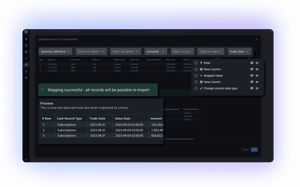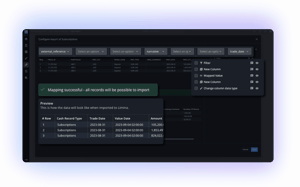
CONNECTIVITY
Configurable data import & export engine (ETL)
Limina’s Investment Management Platform comes with a native Extract, Transform & Load (ETL) application that gives you powerful, configurable connectivity capabilities for import and export use cases. It allows you to easily build integrations with in-house & 3rd party systems and service providers such as custodians, fund admins and more - in minutes, without technical skills needed.
"This is the holy grail of ETL tools"
Configurable connectivity
The configurable import/export tool is embedded into Limina. This application allows for easy configuration of data integrations to and from the platform - without requiring technical expertise. It enables your domain experts, such as your middle office operations team, to easily set up their own data imports. Examples of data include cash records, model portfolio weights, and ESG classifications.
The benefits
By giving these capabilities to the domain experts, it allows for:
- Greatly accelerated time-to-market due to no IT resource dependencies. It also avoids “lost in translation” issues when converting business requirements to technical designs.
- Higher overall automation level since you can now set up integrations with a few clicks, which otherwise wouldn’t be feasible due to the IT cost.
- Significantly lower total cost of ownership. Traditionally, building and maintaining integrations tends to be one of the most significant hidden costs of Investment Management Software. Our import/export tool automatically tests the integrations at each upgrade.
Seamless upgrades, with confidence
In most systems, custom integrations lead to increased risk and effort in upgrade projects, as each integration needs to be tested to ensure it is compatible with the upgraded software. With Limina, this friction is avoided completely, thanks to built-in auto-test functionality for the import & export projects you create.
FAQ
Why not rely exclusively on managed connectivity?
Managed connectivity is when the vendor takes responsibility for setting up and managing an integration. Limina offers this kind of solution. Usually, it’s a cost-effective and stable solution for integrations that many clients share, such as trading and market data integrations.
Managed connectivity can become expensive in more specific cases, such as connecting to back-office systems/providers. For these particular cases, configuring the connectivity yourself – or with help from a consultancy firm – is usually much more cost-efficient.
You’re also less reliant on the vendor when making changes. With an ETL tool, a new integration can be built without software changes, meaning you can get started right away and don’t have to wait for the vendor to prioritise the given integration in their roadmap.
Doesn’t a broad (front-to-mid) solution reduce the number of connections needed?
So-called integrated investment management solutions are, by definition, broad in scope. They usually cover at least Front-to-Mid, Mid-to-Back or Front-to-Back. Hence, there are fewer integrations between systems to manage, as several functional capabilities become natively part of the solution.
Also, you don’t need an Enterprise Data Management Solution (EDM) if you have a solution like Limina. This is because Limina is an Investment Book of Record (IBOR) combined with multiple modern connectivity alternatives.
However, trading, custodians, service providers and market data integrations will always remain. You might also have specialised systems for portfolio construction, risk, performance or more that you’d like to connect.
CURIOUS TO LEARN MORE?
Don't hesitate to get in touch - we're happy to advise on any questions you may have about the product and how it can fit into your landscape and support your target operating model.






